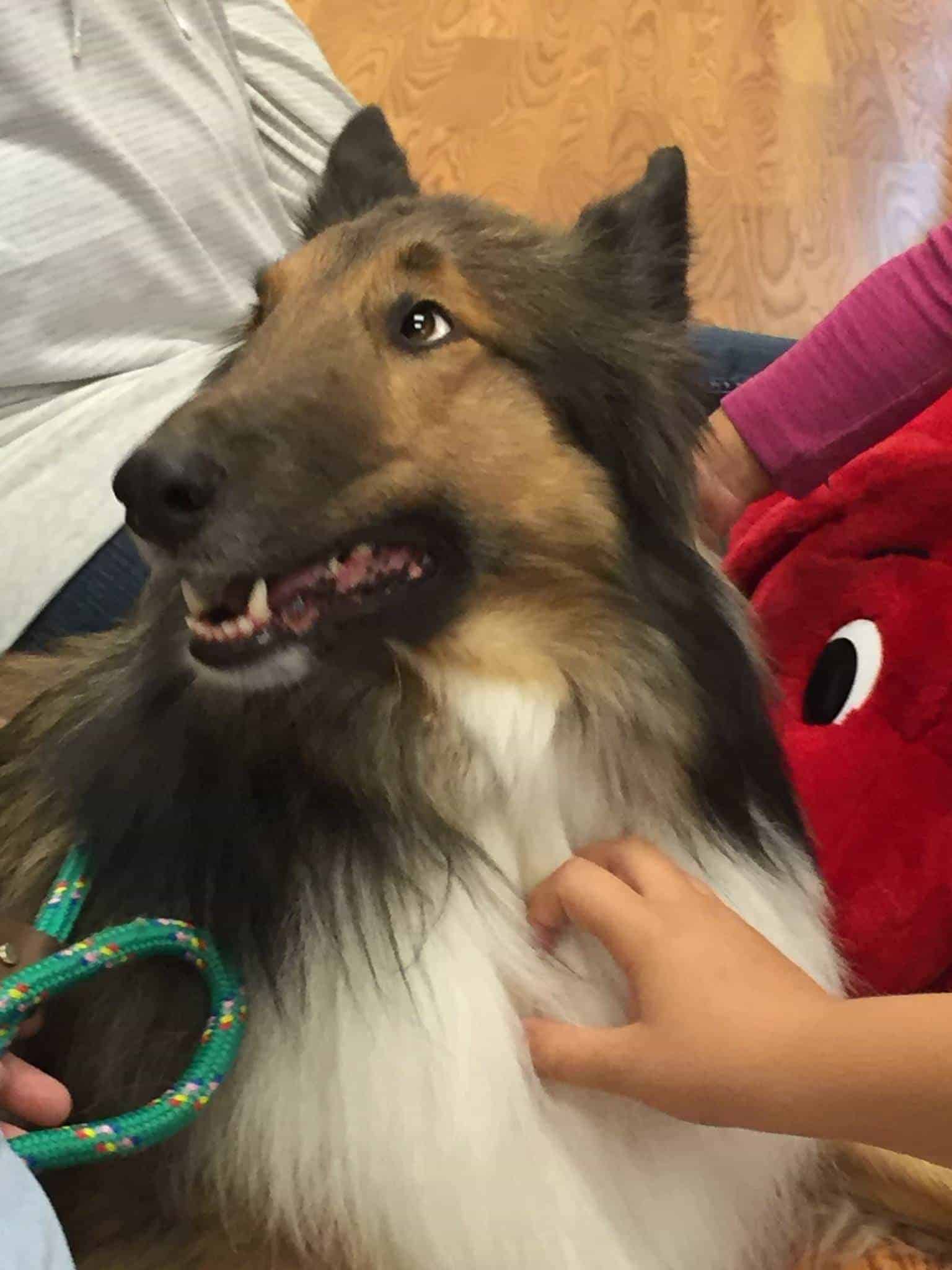Child Advocacy Centers have no shortage of stress, anxiety, and fear, despite being built to put children and families at ease. Anxious families who can’t be with their child during an interview or children nervously waiting for an interview to begin can fill any room with emotion. But at Susie’s Place in Avon, Indiana, a new therapy dog program is helping shift the moods in those rooms.
“The most significant benefit we’ve seen is as soon as the dogs walk in the room. If people are frustrated or tense or whatever emotion they’re bringing, these dogs shift the mood. People shift from “I’m scared” to “Oh my gosh, look at these dogs!” That gives us a catalyst to start a conversation,” says Emily Perry, an 18-year veteran in child protection who has spent the last eight years as the Executive Director of Susie’s Place. Susie’s Place has two locations in Indiana, one in Avon and another in Bloomington. Susie’s Place has seen steadily growing services and caseload. In 2015, Susie’s Place conducted nearly 1,000 interviews between their two Centers.
Susie’s Place is finding the purpose of therapy dogs is as varied as the personality of the dogs themselves. “There isn’t a cookie-cutter approach” to their use, says Perry. “But here at Susie’s Place we’ve partnered with privately-owned dogs through the Healing Paws Chapter of Love on a Leash, a national organization that certifies dogs and their handlers. They come to Susie’s Place two to three times a week, primarily to work in the waiting room areas as greeters and anxiety reducers.”
Perry says, “Because of what we do, it takes a certain handler and personality type to be able to hear some of the content of the cases we’re working and to work with the families in a neutral, safe, way. And it obviously takes a certain personality with the dogs. We are kind of picky and choosy about the dogs and handlers that come into our Center. It has to be the complete package.”

Perry calls the dogs “bridge builders” that help build a relationship between the child and interviewer before an interview even begins. There is a solid amount of anecdotal evidence regarding therapy dogs and research is still being done on their quantifiable benefits in places like CACs. But a 2004 study conducted by Dr. Aubrey Fine, a licensed psychologist and professor at California State Polytechnic University, shows the results of a patient survey suggested that having animals present in a therapeutic environment made the therapy “friendlier and less threatening”.
An earlier study in 1986 suggests an empathetic therapist coupled with animals during childhood may help heal an abused child and change behavior that prevents the cycle of abuse as they become adults.
Those findings are discussed in the American Humane Therapy Animals Supporting Kids (TASK) Program manual [PDF]. Susie’s Place discovered TASK after Allie Phillips, from the National District Attorney’s Association conducted a day-long training session for staff and MDT members at Susie’s Place in Avon.
There are benefits beyond helping children and families, too. “We see the dogs build those bridges with children, but our Multidisciplinary Team (MDT) and staff members enjoy having them here, too,” says Perry. “We all get excited about it because we’re also trying to stay healthy in a challenging field of work…and it’s pretty funny when our team members want to take selfies with the dogs.”
“We see the dogs build those bridges with children, but our Multidisciplinary Team (MDT) and staff members enjoy having them here, too.”
While it sounds straightforward for a CAC to quickly find and work with a local therapy dog service, Perry urges other directors and facilities to “do their homework”. “I have had a handful of other CACs asking about animals in their Center. I always say there’s a lot to be considered before having an animal. Like should you have one animal for your Center, or a team with handlers?”
Such considerations include availability. For instance, handlers in rural communities often aren’t readily available. In which case a CAC may consider having their own dedicated therapy dog on-site. “When you choose to have your own animal, if you have any sort of turnover, you really have to think about whether that animal belongs to the organization or to an employee at the organization, for instance,” says Perry.
While the dogs and handlers at Susie’s Place in Avon are volunteers, there are costs associated with the program. Perry says, “We had to bring in a trainer for us and our MDT members. We have to have our carpet and upholstery cleaned every two weeks to keep allergens down. And we had to hire a part-time advocate and move a part-time advocate to full time to manage the program’s schedule. Plus, as the program grows, like into our Bloomington Center, other costs may be associated. We may not always have volunteer handlers and we may need to fundraise.”
At Susie’s Place, dogs work on a consistent schedule each week, for about 4-5 hours at a time. If Susie’s Place staff feels a dog is needed in a special case outside the schedule, they work with Healing Paws to accommodate that.
Just as much as the dogs are there for children, the health of the dogs are equally looked after. Dogs maintain relatively modest workloads to ensure their health, too. “This is exactly the reason we chose to go with handlers instead of having our own therapy dog that stays at our Center. That much consistent trauma can be unhealthy for the dog. I will say, though, that the dogs we have really seem to want to be with the families.”
Facilities don’t have to rely on just dogs, though. Perry adds, “We’ve learned about some centers that are using other animals, like cats and rabbits. So there are some alternatives to dogs.” But it requires some thoughtful approaches to get the same benefits for children and families and ensuring the animal’s personality is the right fit.
In Indiana, Perry is excited about expanding the program into therapy and interview rooms, and how they can help other CACs through the Indiana Chapter of the National Children’s Alliance. “We’re the first for this program in Indiana and we’re happy to do that so the Indiana Chapter will be able to help other CACs explore this option around the state.”
As caseload increases and the Susie’s Place looks toward expanding the availability and uses of therapy dogs, Perry is thrilled with the current results – anecdotal or not. “We have three handlers and five dogs working with us that were the right fit”, says Perry. “It’s a great bridge and benefit to us, our teams, and more importantly to the families and children we serve.”

